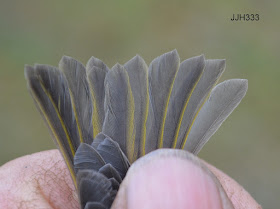Seeing is believing sometimes and certainly is when it comes to a Goldcrest I caught earlier this month and another one I caught today. The first of the two was carrying an old injury, the likes of which I have never seen before, and the second is yet another known age adult with quite pointed tail feathers.
The first bird was caught at Billinge on 15/11/17 and appeared to be fit and healthy apart from having no skin and feathers on the rear of the skull. It was obviously an old injury as the edges of the skin than surrounded the expose portion of skull were dry and showed no signs of redness or infection. I have no idea what caused the injury but it shows how resilient such a small bird can be. It weighed 5.5g and was heavier than 6 of the 7 other Goldcrests caught that morning, 2 of which were larger males, so it was clearly doing OK. The biggest problem that this type of injury will cause is increased heat loss so while it appears to be thriving now its survival chances may be reduced as the weather gets colder, but then all Goldcrests have a tough time surviving when it comes to a cold winter.
 |
| Just looks a little ruffled from the front. |
 |
| Wow! Now that is what you call a bald patch. Would you have believed a bird could survive that if you hadn't seen it. |
 |
| The condition and shape of the tail feathers suggested it was an adult. |
 |
| A real survivor |
The second Goldcrest was a retrap that I caught in the garden this afternoon. It was a male and when I looked at the tail it certainly didn't shout adult but the bird's ring number was from a sequence I was using at the beginning of the year so it had to be one. When I looked up the original ringing details it had been ringed in the garden on 22nd January so there is no question the tail you see in the images below is that of an adult.
 |
| Tail of adult male Goldcrest caught 24/11/17 |
 |
| Tail of adult male Goldcrest caught 24/11/17 |
The outer tail feathers were a bit paler and a bit more pointed than the others but they didn't appear to be as worn or as bleached as I would expect them to be if they were feathers that hadn't been replaced in the last moult. Having said that I have never caught a Goldcrest just prior to undergoing a complete moult or seen one with two generations of feathers so I don't know how worn or bleached old tail feathers get by the time they are normally moulted, let alone a couple of months on. However, I would expect them to look very bleached and extremely worn by now, especially the outers, and be much more obvious than appears to be the case with this bird. Forgetting the outer feathers the rest are quite pointed anyway and nearer the shape many associate with juveniles rather than adults. All 3 of the known age adults I have caught recently have had quite pointed tail feathers and it wouldn't surprise me if most adults have tail feathers with a shape that falls in the intermediate range of adults and juveniles and a good number probably get incorrectly aged as juveniles rather than being left unaged.
Images of the tails of the other known age adults can be found here and here.























